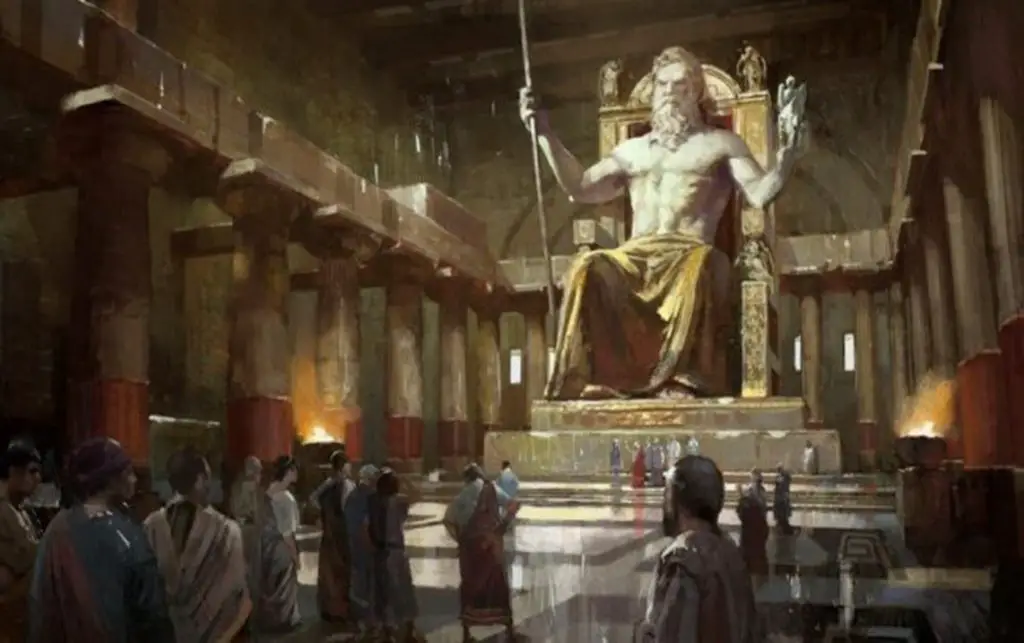The Statue of Zeus, also known as the Zeus at Olympia, was an incredible wonder of the ancient world. It showcased the remarkable skill of Greek sculpture and was dedicated to Zeus, the king of the Greek gods. In this article, we’ll explore the fascinating history, importance, construction, preservation, and cultural impact of the Statue of Zeus.
The Statue of Zeus was created in the 5th century BCE by the renowned Greek sculptor Phidias. It was located in the Temple of Zeus at Olympia in Greece. The statue depicted Zeus seated on a magnificent throne, holding a scepter in one hand and a statue of Nike, the goddess of victory, in the other. It was a truly awe-inspiring representation of Zeus’ power and majesty.
History of the Statue of Zeus

The idea for the Statue of Zeus originated during Athens’ golden age. The Eleans, responsible for the administration of the Olympic Games, wanted to create a monumental tribute to Zeus, the patron deity of the Games. They commissioned Phidias, one of the greatest sculptors of his time, for this extraordinary task.
Description and Significance of the Statue
Standing over 40 feet tall, the Statue of Zeus was one of the tallest statues of its time. It was constructed with a wooden core covered in ivory and gold panels, showcasing the exceptional craftsmanship of Phidias and his team of artisans. The statue held not only religious significance but also symbolized the power and glory of ancient Greece.
Construction and Architecture
Phidias and his team meticulously planned and executed the construction of the Statue of Zeus. They employed a combination of techniques, including wooden framework, clay modeling, and the application of ivory and gold. The intricate details, such as the realistic facial features and drapery, displayed Phidias’ mastery of his craft.
The Temple of Zeus at Olympia
The Statue of Zeus resided within the Temple of Zeus at Olympia, an impressive structure built specifically to house the statue. The temple was a marvel of architecture, featuring a colossal statue hall adorned with elaborate columns and decorations. It served as a pilgrimage site for worshippers and attracted visitors from all corners of the ancient world.
Cultural and Historical Importance

The Statue of Zeus held immense cultural and historical significance for the ancient Greeks. It was considered a symbol of their religious devotion and national pride. The presence of such a grand statue at the Olympic Games elevated the importance of the event and solidified Olympia as a sacred and revered location.
Mythology and Legends Surrounding the Statue
The Statue of Zeus was surrounded by mythical stories and legends. According to one legend, Zeus himself played a role in its creation, imparting it with a divine touch. These myths and tales added to the allure and mystique surrounding the statue.
Preservation and Destruction
Unfortunately, the Statue of Zeus met a tragic fate. It stood for over eight centuries before being destroyed in a fire during the 5th century CE. The exact circumstances of the fire remain unclear, but the loss of this magnificent masterpiece was a significant blow to the artistic and cultural heritage of ancient Greece.
Rediscovery and Modern Influence
Although the original Statue of Zeus no longer exists, its influence can still be seen today. Various descriptions, drawings, and replicas have allowed historians and artists to study and recreate the statue in different forms. Its impact on subsequent generations of sculptors and artists is undeniable.
The Statue of Zeus in Popular Culture
The legacy of the Statue of Zeus extends beyond the ancient world. It has inspired numerous works of literature, art, and films. The grandeur and mythical aura surrounding the statue continue to captivate the imagination of people around the world.
Impact on Art and Sculpture
The Statue of Zeus set a standard of excellence in sculpture. Its realistic portrayal of human anatomy and attention to detail established new benchmarks for future artists. It became a source of inspiration and aspiration for sculptors throughout history.
Controversies and Debates
Throughout its existence, the Statue of Zeus faced controversies and debates. Some criticized the expense and extravagance associated with its creation, while others questioned the appropriateness of dedicating such a grand monument to a pagan deity. These debates reflect the diverse perspectives of different eras.
Conclusion
The Statue of Zeus stands as a testament to the artistic and cultural achievements of ancient Greece. Its grandeur and magnificence captured the essence of Zeus and the power of the Greek gods. Despite its destruction, its legacy endures through the imagination and fascination it continues to evoke.